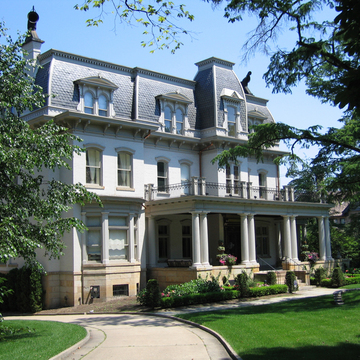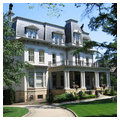You are here
Gwinner-Harter House
This is the second oldest home of what remains from the days when Pittsburgh's 5th Avenue rivaled 5th Avenue in New York City. After World War I, many of the mansions in the Oakland section of 5th Avenue were demolished or turned into apartments, and this occurred here in the Shadyside neighborhood after World War II. This three-story Second Empire–style house built for attorney and banker William B. Negley is one of the few survivors. Edward Gwinner, a stone contractor, purchased the house in 1911, and commissioned Frederick Osterling to design a three-story addition to the west side of the house, and a single-story classically inspired porch in order to update the, by then, old-fashioned house. Gwinner expanded the small central entrance hall into a lavish marble room with an extravagant staircase, reminiscent of mansions in Newport, Rhode Island. In 1923, Osterling returned to design the interiors of three reception rooms; each is paneled in English oak and walnut, and two have carved limestone fireplace surrounds that reach the ceiling.
Dr. Leo Harter acquired the house in 1963 and began a decades-long restoration. In 1987, a fire on the third floor caused extensive damage to the house. Then in 1995, Joedda Sampson, a major force in the renewal of Pittsburgh historic properties, bought and restored the house, and hired Edge Architects for a contemporary redesign of the burnedout third floor's interior. The reborn house is the third in a row of superb 5th Avenue mansions, after the coolly classical Hillman House (1924, Edward P. Mellon) at number 5045 and the Rococo-style Moreland-Hoffstot House (1914, Paul Irwin) at number 5057. Older is the Gothic Revival Willow Cottage
Writing Credits
If SAH Archipedia has been useful to you, please consider supporting it.
SAH Archipedia tells the story of the United States through its buildings, landscapes, and cities. This freely available resource empowers the public with authoritative knowledge that deepens their understanding and appreciation of the built environment. But the Society of Architectural Historians, which created SAH Archipedia with University of Virginia Press, needs your support to maintain the high-caliber research, writing, photography, cartography, editing, design, and programming that make SAH Archipedia a trusted online resource available to all who value the history of place, heritage tourism, and learning.





